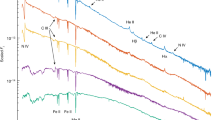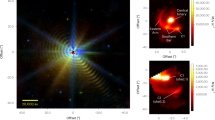Abstract
Cassiopeia A is a nearby young supernova remnant that provides a unique laboratory for the study of core-collapse supernova explosions1. Cassiopeia A is known to be a type IIb supernova from the optical spectrum of its light echo2, but the immediate progenitor of the supernova remains uncertain3. Here, we report results of near-infrared, high-resolution spectroscopic observations of Cassiopeia A, where we detected the pristine circumstellar material of the supernova progenitor. Our observations revealed a strong emission line of iron (Fe) from a circumstellar clump that has not yet been processed by the supernova shock wave. A comprehensive analysis of the observed spectra, together with a Hubble Space Telescope image, indicates that the majority of Fe in this unprocessed circumstellar material is in the gas phase, not depleted onto dust grains as in the general interstellar medium4. This result is consistent with a theoretical model5,6 of dust condensation in material that is heavily enriched with carbon–nitrogen–oxygen cycle nuclear reaction products, supporting the idea that the clump originated near the helium core of the progenitor7,8. It has recently been found that type IIb supernovae can result from the explosion of a blue supergiant with a thin hydrogen envelope9,10,11, and our results support such a scenario for Cassiopeia A.
This is a preview of subscription content, access via your institution
Access options
Access Nature and 54 other Nature Portfolio journals
Get Nature+, our best-value online-access subscription
$29.99 / 30 days
cancel any time
Subscribe to this journal
Receive 12 digital issues and online access to articles
$119.00 per year
only $9.92 per issue
Buy this article
- Purchase on Springer Link
- Instant access to full article PDF
Prices may be subject to local taxes which are calculated during checkout




Similar content being viewed by others
Data availability
The data that support the plots within this paper and other findings of this study are available from the corresponding author upon reasonable request.
References
Milisavljevic, D. & Fesen, R. A. in Handbook of Supernovae (eds Alsabti, A. W. & Murdin, P.) 2211–2231 (Springer, 2017).
Krause, O. et al. The Cassiopeia A supernova was of type IIb. Science 320, 1195–1197 (2008).
Chevalier, R. A. & Soderberg, A. M. Type IIb supernovae with compact and extended progenitors. Astrophys. J. Lett. 711, L40–L43 (2010).
Savage, B. D. & Sembach, K. R. Interstellar abundances from absorption-line observations with the Hubble Space Telescope. Annu. Rev. Astron. Astrophys. 34, 279–330 (1996).
Gail, H.-P., Duschl, W. J., Ferrarotti, A. S. & Weis, K. Dust formation in LBV envelopes. In The Fate of the Most Massive Stars (eds Humphreys, R. & Stanek, K.) 317–319 (ASP Conference Series Vol. 332, ASP, 2005).
Gail, H.-P. in Astromineralogy 2nd edn (ed. Henning, T.) 61–141 (Lecture Notes in Physics Vol. 815, Springer, 2010).
Chevalier, R. A. & Kirshner, R. P. Spectra of Cassiopeia A. II. Interpretation. Astrophys. J. 219, 931–941 (1978).
Lamb, S. A. The Cassiopeia A progenitor: a consistent evolutionary picture involving supergiant mass loss. Astrophys. J. 220, 186–192 (1978).
Meynet, G. et al. Impact of mass-loss on the evolution and pre-supernova properties of red supergiants. Astron. Astrophys. 575, A60 (2015).
Yoon, S.-C., Dessart, L. & Clocchiatti, A. Type Ib and IIb supernova progenitors in interacting binary systems. Astrophys. J. 840, 10 (2017).
Kilpatrick, C. D. et al. On the progenitor of the type IIb supernova 2016gkg. Mon. Not. R. Astron. Soc. 465, 4650–4657 (2017).
Smith, N. Mass loss: its effect on the evolution and fate of high-mass stars. Annu. Rev. Astron. Astrophys. 52, 487–528 (2014).
Thorstensen, J. R., Fesen, R. A. & van den Bergh, S. The expansion center and dynamical age of the Galactic supernova remnant Cassiopeia A. Astron. J. 122, 297–307 (2001).
Chevalier, R. A. & Oishi, J. Cassiopeia A and its clumpy presupernova wind. Astrophys. J. Lett. 593, L23–L26 (2003).
van Veelen, B., Langer, N., Vink, J., García-Segura, G. & van Marle, A. J. The hydrodynamics of the supernova remnant Cassiopeia A. The influence of the progenitor evolution on the velocity structure and clumping. Astron. Astrophys. 503, 495–503 (2009).
Hwang, U. & Laming, J. M. The circumstellar medium of Cassiopeia A inferred from the outer ejecta knot properties. Astrophys. J. 703, 883–893 (2009).
Lee, J.-J., Park, S., Hughes, J. P. & Slane, P. O. X-ray observation of the shocked red supergiant wind of Cassiopeia A. Astrophys. J. 789, 7 (2014).
Baade, W. & Minkowski, R. Identification of the radio sources in Cassiopeia, Cygnus A, and Puppis A. Astrophys. J. 119, 206–214 (1954).
Kamper, K. & van den Bergh, S. Optical studies of Cassiopeia A. V. A definitive study of proper motions. Astrophys. J. Suppl. Ser. 32, 351–366 (1976).
van den Bergh, S. & Kamper, K. Optical studies of Cassiopeia A. VII. recent observations of the structure and evolution of the nebulosity. Astrophys. J. 293, 537–541 (1985).
Lawrence, S. S. et al. Three-dimensional Fabry–Perot imaging spectroscopy of the Crab Nebula, Cassiopeia A, and nova GK Persei. Astron. J. 109, 2635–2893 (1995).
Alarie, A., Bilodeau, A. & Drissen, L. A hyperspectral view of Cassiopeia A. Mon. Not. R. Astron. Soc. 441, 2996–3008 (2014).
Hurford, A. P. & Fesen, R. A. Reddening measurements and physical conditions for Cassiopeia A from optical and near-infrared spectra. Astrophys. J. 469, 246–254 (1996).
Gerardy, C. L. & Fesen, R. A. Near-infrared spectroscopy of the Cassiopeia A and Kepler supernova remnants. Astron. J. 121, 2781–2791 (2001).
Lee, Y.-H., Koo, B.-C., Moon, D.-S., Burton, M. G. & Lee, J.-J. Near-infrared knots and dense Fe ejecta in the Cassiopeia A supernova remnant. Astrophys. J. 837, 118 (2017).
McKee, C. F. & Cowie, L. L. The interaction between the blast wave of a supernova remnant and interstellar clouds. Astrophys. J. 195, 715–725 (1975).
Chevalier, R. A. & Liang, E. P. The interaction of supernovae with circumstellar bubbles. Astrophys. J. 344, 332–340 (1989).
Fesen, R. A., Becker, R. H. & Blair, W. P. Discovery of fast-moving nitrogen-rich ejecta in the supernova remnant Cassiopeia A. Astrophys. J. 313, 378–388 (1987).
Koo, B.-C. et al. A deep near-infrared [Fe ii] + [Si i] emission line image of the supernova remnant Cassiopeia A. Astrophys. J. 866, 139 (2018).
Koo, B.-C., Raymond, J. C. & Kim, H.-J. Infrared [Fe ii] emission lines from radiative atomic shocks. J. Kor. Astron. Soc. 49, 109–122 (2016).
Walmsley, C. M., Natta, A., Oliva, E. & Testi, L. The structure of the Orion bar. Astron. Astrophys. 364, 301–317 (2000).
Morris, P. W. et al. η Carinae’s dusty Homunculus Nebula from near-infrared to submillimeter wavelengths: mass, composition, and evidence for fading opacity. Astrophys. J. 842, 79 (2017).
Aldering, G., Humphreys, R. M. & Richmond, M. SN 1993J: the optical properties of its progenitor. Astron. J. 107, 662–672 (1994).
Yuk, I.-S. et al. Preliminary design of IGRINS (Immersion GRating INfrared Spectrograph). In Ground-based and Airborne Instrumentation for Astronomy III (eds McLean, I. S. et al.) 77351M (SPIE, 2010).
Park, C. et al. Design and early performance of IGRINS (Immersion Grating Infrared Spectrometer). In Ground-based and Airborne Instrumentation for Astronomy V (eds Ramsay, S. K. et al.) 91471D (SPIE, 2014).
Mace, G. et al. IGRINS at the Discovery Channel Telescope and Gemini South. In Ground-based and Airborne Instrumentation for Astronomy VII (eds Evans, C. J. et al.) 107020Q (SPIE, 2018).
Lee, J.-J., Gullikson, K. & Kaplan, K. F. IGRINS pipeline package (IGRINS/PLP) v.2.2.0 (2017); https://doi.org/10.5281/zenodo.845059
Kaplan, K. F. et al. Excitation of molecular hydrogen in the Orion bar photodissociation region from a deep near-infrared IGRINS spectrum. Astrophys. J. 838, 152 (2017).
Draine, B. T. Scattering by interstellar dust grains. I. Optical and ultraviolet. Astrophys. J. 598, 1017–1025 (2003).
Allen, M. G., Groves, B. A., Dopita, M. A., Sutherland, R. S. & Kewley, L. J. The MAPPINGS III library of fast radiative shock models. Astrophys. J. Suppl. Ser. 178, 20–55 (2008).
Ramsbottom, C. A., Hudson, C. E., Norrington, P. H. & Scott, M. P. Electron-impact excitation of Fe ii. Collision strengths and effective collision strengths for low-lying fine-structure forbidden transitions. Astron. Astrophys. 475, 765–769 (2007).
Deb, N. C. & Hibbert, A. Radiative transition rates for the forbidden lines in Fe ii. Astron. Astrophys. 536, A74 (2011).
Nussbaumer, H. & Storey, P. J. Atomic data for Fe ii. Astron. Astrophys. 89, 308–313 (1980).
Nussbaumer, H. & Storey, P. J. Transition probabilities for Fe ii infrared lines. Astron. Astrophys. 193, 327–333 (1988).
Asplund, M., Grevesse, N., Sauval, A. J. & Scott, P. The chemical composition of the Sun. Annu. Rev. Astron. Astrophys. 47, 481–522 (2009).
Draine, B. T. Physics of the Interstellar and Intergalactic Medium (Princeton Univ. Press, 2011).
Drout, M. R., Massey, P., Meynet, G., Tokarz, S. & Caldwell, N. Yellow supergiants in the Andromeda Galaxy (M31). Astrophys. J. 703, 441–460 (2009).
Reed, J. E., Hester, J. J., Fabian, A. C. & Winkler, P. F. The three-dimensional structure of the Cassiopeia A supernova remnant. I. The spherical shell. Astrophys. J. 440, 706–721 (1995).
Paxton, B. et al. Modules for Experiments in Stellar Astrophysics (MESA). Astrophys. J. Suppl. Ser. 192, 3 (2011).
Acknowledgements
We thank R. Fesen for comments on the manuscript. This research was supported by the Basic Science Research Program through the National Research Foundation of Korea (NRF) funded by the Ministry of Science, ICT and Future Planning (2017R1A2A2A05001337). This work used the IGRINS, which was developed under a collaboration between the University of Texas at Austin and the Korea Astronomy and Space Science Institute (KASI), with the financial support of the US National Science Foundation under grant AST-1229522, of the University of Texas at Austin and of the Korean GMT Project of KASI. These results made use of the DCT at Lowell Observatory. Lowell is a private, non-profit institution dedicated to astrophysical research and public appreciation of astronomy and operates the DCT in partnership with Boston University, the University of Maryland, the University of Toledo, Northern Arizona University and Yale University. This work is based in part on observations made with the NASA/ESA Hubble Space Telescope, obtained from the data archive at the Space Telescope Science Institute (STScI). STScI is operated by the Association of Universities for Research in Astronomy, Inc. under NASA contract NAS 5-26555.
Author information
Authors and Affiliations
Contributions
B.-C.K. led the project, analysis and discussion and wrote the manuscript. H.-J.K. performed the observation and data reduction and contributed to the data analysis and manuscript writing. H.O. performed the observation and contributed to the IGRINS data analysis. J.C.R. contributed to the shock emission analysis and scientific interpretation. S.-C.Y. contributed to the scientific interpretation and the manuscript writing. Y.-H.L. contributed to the HST data analysis. D.T.J. contributed to the project set-up. All authors commented on the manuscript.
Corresponding author
Ethics declarations
Competing interests
The authors declare no competing interests.
Additional information
Publisher’s note Springer Nature remains neutral with regard to jurisdictional claims in published maps and institutional affiliations.
Supplementary information
Supplementary Information
Supplementary Information, Tables 1 and 2 and Figs. 1–3.
Rights and permissions
About this article
Cite this article
Koo, BC., Kim, HJ., Oh, H. et al. Detection of pristine circumstellar material from the Cassiopeia A supernova progenitor. Nat Astron 4, 584–589 (2020). https://doi.org/10.1038/s41550-019-0996-4
Received:
Accepted:
Published:
Issue Date:
DOI: https://doi.org/10.1038/s41550-019-0996-4



